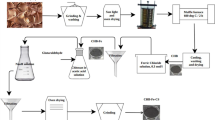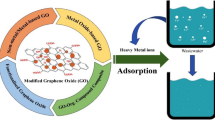Abstract
Alginate-enfolded copper hexacyanoferrate (CuHCF) graphene oxide granules (CGAGs) were prepared and showed excellent mechanical strength and water-swelling resistance. The maximum adsorption capacity was 50.5 mg/g. The distribution coefficient reached the maximum at pH 5.0, and was almost unaffected by the coexisted metal ions (K+, Na+, Ca2+, Mg2+, less than 20 mg/L). With the flow rate of 1.2 mL/min and the feed concentration of 20 mg/L, the efficiency of the fixed-bed column was calculated as 60.6%. These results suggested that CGAGs could be an alternative adsorbent for removing low-concentration cesium from the contaminated potable water and surface water so on.









Similar content being viewed by others
References
Kadam AA, Jang J, Lee DS (2016) Facile synthesis of pectin-stabilized magnetic graphene oxide prussian blue nanocomposites for selective cesium removal from aqueous solution. Bioresour Technol 216:391
Jang J, Lee DS (2016) Enhanced adsorption of cesium on PVA-alginate encapsulated prussian blue-graphene oxide hydrogel beads in a fixed-bed column system. Bioresour Technol 218:294
Liu X, Chen GR, Lee DJ, Kawamoto T, Tanaka H, Chen ML, Luo YK (2014) Adsorption removal of cesium from drinking waters: a mini review on use of biosorbents and other adsorbents. Bioresour Technol 160:142
Wang J, Zhuang S, Liu Y (2018) Metal hexacyanoferrates-based adsorbents for cesium removal. Coord Chem Rev 374:430
Thierry V, Chloë V, Eric G (2015) Immobilization of metal hexacyanoferrate ion-exchangers for the synthesis of metal ion sorbents—a mini-review. Molecules 20:20582
Nilchi A, Saberi R, Moradi M, Azizpour H, Zarghami R (2011) Adsorption of cesium on copper hexacyanoferrate–PAN composite ion exchanger from aqueous solution. Chem Eng J 172:572
Clarke TD, Wai CM (1998) Selective removal of cesium from acid solutions with immobilized copper ferrocyanide. Anal Chem 70:3708
Rao SV, Lal KB, Narasimhan SV, Ahmed J (1999) Copper ferrocyanide—polyurethane foam as a composite ion exchanger for removal of radioactive cesium. J Radioanal Nucl Chem 240:269
Milonjić S, Bispo I, Fedoroff M, Loosneskovic C, Vidalmadjar C (2002) Sorption of cesium on copper hexacyanoferrate/polymer/silica composites in batch and dynamic conditions. J Radioanal Nucl Chem 252:497
Sangvanich T, Sukwarotwat V, Wiacek RJ, Grudzien RM, Fryxell GE, Addleman RS, Timchalk C, Yantasee W (2010) Selective capture of cesium and thallium from natural waters and simulated wastes with copper ferrocyanide functionalized mesoporous silica. J Hazard Mater 182:225
Park Y, Kim C, Choi S (2015) Selective removal of Cs using copper ferrocyanide incorporated on organically functionalized silica supports. J Radioanal Nucl Chem 303:199
Wang L, Feng M, Liu C, Zhao Y, Li S, Wang H, Li S (2009) Supporting of potassium copper hexacyanoferrate on porous activated carbon substrate for cesium separation. Sep Sci Technol 44:4023
Dwivedi C, Kumar A, Singh KK, Juby AK, Kumar M, Wattal PK, Bajaj PN (2013) Copper hexacyanoferrate–polymer composite beads for cesium ion removal: synthesis, characterization, sorption, and kinetic studies. J Appl Polym Sci 129:152
Chaudhury S, Pandey AK, Goswami A (2015) Copper ferrocyanide loaded track etched membrane: an effective cesium adsorbent. J Radioanal Nucl Chem 304:697
Kim YK, Kim T, Kim Y, Harbottle D, Lee JW (2017) Highly effective Cs+ removal by turbidity-free potassium copper hexacyanoferrate-immobilized magnetic hydrogels. J Hazard Mater 340:130
Basu H, Saha S, Pimple MV, Singhal RK (2018) Graphene-prussian blue nanocomposite impregnated in alginate for efficient removal of cesium from aquatic environment. J Environ Chem Eng 6:4399
Vipin AK, Hu B, Fugetsu B (2013) Prussian blue caged in alginate/calcium beads as adsorbents for removal of cesium ions from contaminated water. J Hazard Mater 258:93
Yang H, Li H, Zhai J, Sun L, Zhao Y, Yu H (2014) Magnetic prussian blue/graphene oxide nanocomposites caged in calcium alginate microbeads for elimination of cesium ions from water and soil. Chem Eng J 246:10
Lai YC, Chang YR, Chen ML, Lo YK, Lai JY, Lee DJ (2016) Poly(vinyl alcohol) and alginate cross-linked matrix with immobilized prussian blue and ion exchange resin for cesium removal from waters. Bioresour Technol 214:192
Saha S, Basu H, Pimple MV, Singhal RK (2018) Alginate impregnated ferric hexacyanoferrate(II) for effective decontamination of cesium from aquatic environment. J Radioanal Nucl Chem 318:1827
Dwivedi C, Pathak SK, Kumar M, Tripathi SC, Bajaj PN (2013) Potassium cobalthexacyanoferrate–gel beads for cesium removal: kinetics and sorption studies. RSC Adv 3:22102
Vipin AK, Ling S, Fugetsu B (2014) Sodium cobalt hexacyanoferrate encapsulated in alginate vesicle with CNT for both cesium and strontium removal. Carbohydr Polym 111:477
Majidnia Z, Idris A (2015) Evaluation of cesium removal from radioactive waste water using maghemite PVA–alginate beads. Chem Eng J 262:372
Jeon C (2016) Removal of cesium ions from aqueous solutions using immobilized nickel hexacyanoferrate-sericite beads in the batch and continuous processes. J Ind Eng Chem 40:93
Lee CP, Tsai SC, Wu MC, Tsai TL (2018) A study on removal of Cs and Sr from aqueous solution by bentonite–alginate microcapsules. J Radioanal Nucl Chem 318:2381
Lee K, Kawamoto T, Minami K, Takahashi A, Parajuli D, Kido G, Yoshino K, Tanaka H (2016) Improved adsorption properties of granulated copper hexacyanoferrate with multi-scale porous networks. RSC Adv 6:16234
Parajuli D, Takahashi A, Noguchi H, Kitajima A, Tanaka H, Takasaki M, Yoshino K, Kawamoto T (2016) Comparative study of the factors associated with the application of metal hexacyanoferrates for environmental Cs decontamination. Chem Eng J 283:1322
Ishizaki M, Kanaizuka K, Abe M, Hoshi Y, Sakamoto M, Kawamoto T, Tanaka H, Kurihara M (2012) Preparation of electrochromic Prussian blue nanoparticles dispersible into various solvents for realisation of printed electronics. Green Chem 14:1537
Alamudy HA, Cho K (2018) Selective adsorption of cesium from an aqueous solution by a montmorillonite-Prussian blue hybrid. Chem Eng J 349:595
Ng CW, Ding J, Shi Y, Gan LM (2001) Structure and magnetic properties of copper(II) hexacyanoferrate(III) compound. J Phys Chem Solids 62:767
Park S, An J, Piner RD, Jung I, Yang D, Velamakanni A, Nguyen SBT, Ruoff RS (2008) Aqueous suspension and characterization of chemically modified graphene sheets. Chem Mater 20:6592
Ricci F, Amine A, Palleschi G, Moscone D (2003) Prussian blue based screen printed biosensors with improved characteristics of long-term lifetime and pH stability. Biosens Bioelectron 18:165
Sheha RR (2012) Synthesis and characterization of magnetic hexacyanoferrate(II) polymeric nanocomposite for separation of cesium from radioactive waste solutions. J Colloid Interface Sci 388:21
Kim YK, Bae K, Kim Y, Harbottle D, Lee JW (2018) Immobilization of potassium copper hexacyanoferrate in doubly crosslinked magnetic polymer bead for highly effective Cs+ removal and facile recovery. J Ind Eng Chem 68:48
Zong Y, Zhang Y, Lin X, Dong Y, Dan Q, Zeng S (2017) Facile synthesis of potassium copper ferrocyanide composite particles for selective cesium removal from wastewater in the batch and continuous processes. RSC Adv 7:31352
Acknowledgements
The research was supported by the National Key Research and Development Program of China (2016YFC1402504) and the Young Elite Scientist Sponsorship Program of the China Association of Science and Technology (No. 2017QNRC001).
Author information
Authors and Affiliations
Corresponding author
Additional information
Publisher's Note
Springer Nature remains neutral with regard to jurisdictional claims in published maps and institutional affiliations.
Rights and permissions
About this article
Cite this article
Li, X., Wu, X., Chen, J. et al. Alginate-enfolded copper hexacyanoferrate graphene oxide granules for adsorption of low-concentration cesium ions from aquatic environment. J Radioanal Nucl Chem 320, 655–663 (2019). https://doi.org/10.1007/s10967-019-06511-y
Received:
Published:
Issue Date:
DOI: https://doi.org/10.1007/s10967-019-06511-y




